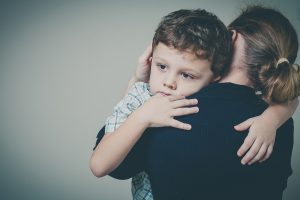Can Attachment Theory Explain All Our Relationships?
One mother’s journey through the science of attachment theory.
 The stage is set: a room with two chairs and some toys on the floor. A mother and her 1-year-old baby enter and begin the Strange Situation, a 20-minute, eight-episode laboratory experiment to measure “attachment” between infants and their caregivers.
The stage is set: a room with two chairs and some toys on the floor. A mother and her 1-year-old baby enter and begin the Strange Situation, a 20-minute, eight-episode laboratory experiment to measure “attachment” between infants and their caregivers.
Through a one-way mirror, researchers observe the pair, cataloging every action and reaction. It doesn’t take long to determine the baby’s baseline temperament: physical, running to every corner of the room; inquisitive, intently exploring and mouthing every block; or reserved, wistfully holding a wind-up toy. The mother is told to sit down and read a magazine so the baby can do whatever she is naturally drawn to do. Then a stranger comes in, and the baby’s reaction is observed — is she afraid of the stranger, nonchalant, or drawn to her? This indicates the style of relating to people in general, and to the mother by comparison.
The mother is instructed to leave the room, leaving her purse on the chair, a sign that she will return. Here we see how the baby responds to the experience of being left — does she howl and run to the door? Or does she stay put, on the floor, in a mountain of toys? The stranger tries to soothe the baby if she is upset. Otherwise, she leaves her to keep exploring.
After a few minutes, cut short if the baby is truly under duress (but that happens rarely), the mother returns for Reunion No. 1. The theory of attachment holds that a behavioral system has evolved to keep infants close to their caregivers and safe from harm. The presumption is that all babies will be under stress when left alone (and in fact, heart rate and cortisol levels indicate that even babies who don’t appear distressed still are). So when the mother returns to the room, researchers are watching to see whether the relationship works as it should. Does the reunion do its job of bringing the baby from a state of relative anxiety into a state of relative ease? In other words, is the child soothed by the presence of the mother?
If the baby was upset during separation but sits still as a stone when her mother returns, it’s likely a sign of an insecure attachment. If the baby was relaxed when left alone and is nonplussed by reunion, that’s less significant. If the baby hightails it to her mother, then screeches mid-approach, indicating a change of heart, that’s a worrisome sign too.
But the most important moment is Reunion No. 2, after the mother leaves again and returns again. If a baby who was upset during separation still does nothing to acknowledge her mother’s return, it’s a sign that the baby, at only a year old, has already come to expect her advances to be rebuffed. If the baby reaches out for love but isn’t able to settle down enough to receive it (or it’s not offered), that may reflect a relationship filled with mixed messages. And if the baby is wild with sadness then jumps like a monkey into the mother’s arms and immediately stops crying, the baby is categorized as secure, coming from a relationship in which she expects her needs to be met. The same goes for a mellow baby whose cues are more subtle, who simply looks sad during separation, then moves closer to Mother upon reunion. In both cases, the relationship works. (And just to be clear, a “working” relationship has nothing to do with the baby-wearing and co-sleeping and round-the-clock care popularized by Dr. William Sears’s attachment-parenting movement; plenty of secure attachments are formed without following any particular parenting philosophy.)
Separate, connect. Separate, connect. It’s the primal dance of finding ourselves in another, and another in ourselves. Researchers believe this pattern of attachment, assessed as early as one year, is more important than temperament, IQ, social class, and parenting style to a person’s development. A boom in attachment research now links adult attachment insecurity with a host of problems, from sleep disturbances, depression, and anxiety to a decreased concern with moral injustice and less likelihood of being seen as a “natural leader.” But the biggest subfield of attachment research is concerned, not surprisingly, with adult attachment in romantic relationships (yes, there’s a quiz). Can we express our needs? Will they be met? If our needs are met, can we be soothed? Adults with high attachment security are more likely to be satisfied in marriage, experience less conflict, and be more resistant to divorce.
The trouble is that only around 60 percent of people are considered “secure.” Which, of course, means that a good lot of us have some issues with attachment, which gets passed from generation to generation. Because if you had an insecure attachment with your parents, it is likely that you will have a more difficult time creating secure attachments for your own children.
The poet Philip Larkin was not the first or the last to notice that parents, “they fuck you up.”
When my daughter Azalea was born, I was flooded with feelings of love. But it wasn’t long before I returned to a more familiar sense of myself, and that love was mixed with ambivalence, internal conflict, impatience, and sometimes anger. Yes, I adored my baby, the way she nose-breathed on me as she nursed, her milky smell, her beautiful face, her charming smiles, her bright energy. Her. I loved her. But I was exhausted and overwhelmed, and what might be expressed as irritability in some parents felt more like rage to me. I knew better than to express anger at a baby, but my control dials felt out of reach. I never hit or shook my daughter, but I did yell at her, in real and frightening fury. One time, when she was 6 months old, she was supposed to be taking a nap, but instead she was pulling herself up in her crib, over and over again, nonstop crying. I was over it, done, nothing left. I sat on the floor in her darkened room, and made my ugliest, angriest, face at her, seething, yelling at her to just…go…to…SLEEP.
If this had been a one-off, I could have rationalized that every parent loses it at some point. But this kind of heat was all too available to me. I would occasionally confess my behavior to my husband, a psychotherapist, but he rarely saw it up close. So as much as he, my own therapist, and my friends tried to support us both, I was largely alone in my shame. And my daughter was alone with a warm and loving and sometimes scary mom.
I had read Dr. Sears and his attachment-parenting ideas before Azalea was born, but I was deeply suspicious that a checklist of behaviors could teach anyone how to raise a human being. I would read things like “Respond to your baby’s cues,” and think, Right. As if. Her cues were often inscrutable and always exhausting. Sears’s cavalier oversimplification annoyed me to no end and added to the weight of expectations and disappointment.
As Azalea grew, some things got easier. Language helped. Her ever-increasing cuteness and sweetness helped. Our connection developed, and I loved doing things together — reading books, going to Target, cooking, cuddling, walking, hanging out with friends. Things were good. Except when they weren’t. Like the time in the grocery store as I was checking out with Thanksgiving groceries while struggling to manage Azalea’s unwieldy 10-month-old body in front of a line of blankly staring, silently huffing adults. I remember the jaw-setting, skin-tingling, adrenaline-pumping feeling of anger overtake me. While I don’t remember exactly what I said to my squirming baby, I will never forget the disgusted look on the checkout lady’s face, confirming that whatever outburst I settled on was definitely not okay.
In my dark moments, I felt like something inside me was missing, that thing that functions deep down that keeps us from hurting the people we love. But I also tried to remind myself that the cult of perfect parenthood is a myth, that there is no way to avoid making a mess of our kids one way or another. That gave me some peace. Then, when Azalea was 4, I interviewed Jon Kabat-Zinn, the mindfulness and meditation expert who has written many books, including Everyday Blessings: The Inner Work of the Mindful Parent. I think I was hoping he might encourage me to set down my burden of guilt and shame, maybe even offer a God-like let it go. But that wasn’t what happened.
Kabat-Zinn: The meaning of being a parent is that you take responsibility for your child’s life until they can take responsibility for their own life. That’s it!
Me: That’s a lot.
Kabat-Zinn: True, and it doesn’t mean you can’t get help. Turns out how you are as a parent makes a huge difference in the neural development of your child for the first four or five years.
Me: That is so frightening.
Kabat-Zinn: All that’s required, though, is connection. That’s all.
Me: But I want to be separate from my child; I don’t want to be connected all the time.
Kabat-Zinn: I see. Well, everything has consequences. How old is your child?
Me: Four and a half.
Kabat-Zinn: Well, I gotta say, I have very strong feelings about that kind of thing. She didn’t ask to be born.
I knew then that I needed to figure out why I am the kind of mother I am, and what effect it was having on my daughter.

In this Webinar: This online workshop with Dr. Lisa Firestone will provide tools to help people heal insecure attachment, resolve trauma, integrate their…
What began as a quiet inkling that studying attachment might help me understand my vast and varied shortcomings as a mother unfolded into a bona-fide obsession with the entire field of attachment research, inspiring me to write a book and to sign up for training in the Strange Situation. So last August I traveled to Minneapolis where, for the past 30 years, professor Alan Sroufe, co-creator of what has become known as theMinnesota Study, a seminal, 30-year longitudinal study of attachment, has trained researchers, grad students, clinicians, and intrigued writers to become reliable coders of the Strange Situation. I knew that only through training could I learn to discern the bedrock of an infant’s most important relationship. I wanted to become that trained eye.
From our seats in a big classroom, students from around the world — Italy, Peru, New Zealand, Mexico, Israel, Japan, and Zambia — watched several videotaped Strange Situations a day, spanning the history and breadth of the field itself, from early, grainy footage with American moms wearing Gloria Vanderbilts and wedge sandals to HD-quality contemporary Swedish pairs. The action is so simple — alone, together, alone, together — it’s almost lyrical. Though the Strange Situation has been done with fathers and other primary caregivers (and monkeys!), the structure is always the same and always points to one thing: the crazy, difficult, beautiful, mysterious nature of trying to love someone.
At the beginning, I was lost. I couldn’t track the action, let alone what mattered, and I got distracted by the wrong details, or hung up on my own reactions. Is it the whiny babies who are insecure and the robust, easygoing ones who are secure? Not necessarily. Attachment is not about temperament. If a big crier is soothed by his mother’s return, he is securely attached. If an anxious kid knows how to scramble for safety and feel felt, it’s another good sign. This is why the Strange Situation works so well — it highlights the relationship while controlling for almost everything else.
 Eventually, I learned how to read the cues, and I began to notice the quickest glance and connect it with the rest of the baby’s behavior. I began to notice the difference between a full-on wrap-around-the-legs greeting and a limp request for contact, and the significance of each. I started to wonder about the baby who reached up to be held and kicked at the same time. And I began to worry about all those “good” babies who just sat there, moving shapes around the floor, unaffected by their lifeline’s comings and goings.
Eventually, I learned how to read the cues, and I began to notice the quickest glance and connect it with the rest of the baby’s behavior. I began to notice the difference between a full-on wrap-around-the-legs greeting and a limp request for contact, and the significance of each. I started to wonder about the baby who reached up to be held and kicked at the same time. And I began to worry about all those “good” babies who just sat there, moving shapes around the floor, unaffected by their lifeline’s comings and goings.
While attachment behaviors look different across cultures, the attachment system itself is universal. All babies fall into one of the patterns: Secure (B), Insecure/Avoidant (A), and Insecure/Resistant (C). (There are also eight subgroups and a whole other strain within these categories called disorganization.) In the case of Avoidant babies, there is often little or no acknowledgment of the mother’s return. The chill in the air is unnerving. The marker of the avoidant baby, as opposed to the secure one who simply doesn’t need as much contact, is either a subtle averting of their gaze, or an overt change of direction en route to connection. You can see babies literally change their mind as they make a beeline for comfort. Resistant babies, meanwhile, are pissed — kicking, arching, hitting. They make a big show of wanting contact, but they are unable to settle even after the one they desire has returned.
B-4 is a subgroup of secure babies who express a lot, need a lot, can be a bit feisty, but who know where their bread is buttered. My favorite Strange Situation starred a little B-4 girl in a lavender dress who reminded me of Azalea. Sitting in the darkened classroom, I watched the baby toddle around in her little sneakers, bawling her head off when her mother, a thin, sad-seeming young woman with ’80s hair and Reeboks, left. But when the mother returned, the baby ran to her and was immediately picked up. The crying stopped. This was not one of those moms with tons of affect and big expressions of there, there. She just picked her up, and the baby molded right to her, put her head on her shoulder, and then (and this is the best thing ever) the mother and daughter patted each other’s shoulders simultaneously. Co-regulation, a mirror. Then the baby got back on the floor to play.
I thought back to when my daughter Azalea was that age, wearing dresses with giant bows, walking on stiff legs, flyaway curls in pig tails — an adorable, willful, comfort-seeking missile. Then there was me, self-concerned, kind of unavailable, moody, angry. I looked around at all the mothers and daughters and fathers and sons in the classroom, staring up at the big screen, as this sad-looking mother and her big-feeling daughter showed us all how it’s supposed to be done, each of us probably wondering the same thing: What about me? What about her? What about us?
Before attachment theory came into view in the 1950s, the field of developmental psychology was very much focused on the interior drives of each individual, not their relationships. Then a British psychoanalyst named John Bowlby came along and made the case that relationships mattered more than anyone had previously suspected. His theory, influenced by the study of animal behavior, was that primates require a primary caregiver for survival, not as a means to receive food (as the behaviorists believed), but in order to be and feel close to a protective adult. According to Bowlby, it was in service to this goal of real and felt security that certain so-called “attachment behaviors” had evolved to elicit a caregiver’s response — crying, following, smiling, sucking, clinging. In other words, babies had evolved to send signals to their caregivers when vulnerable (afraid, sick, hurt, etcetera) that required a response (picking up, cuddling, tending to, etcetera) that kept them safe from danger. At the heart of the attachment system is a primitive kind of call and response that keeps the species alive.
While Bowlby is known as the father of attachment, a prodigiously smart psychologist who worked briefly as his researcher, Mary Salter Ainsworth, is the one who brought his theory to life. In 1954, Ainsworth’s husband got a job in Uganda and she accompanied him, determined to set up a research project testing her and Bowlby’s budding theory with real people. After a year of observing Ganda mothers and babies, she noticed that the babies who cried the least had the most attentive mothers. And she saw how “maternal attunement” to babies’ cues seemed to determine these patterns.
While previous studies had noted of a mother’s “warmth,” or a child’s smiles or cries, what made Ainsworth’s observations original was that she noticed relational sensitivity, the actual relationship between two beings. The sensitive caregiver, she writes, “picks [the baby] up when he seems to wish it, and puts him down when he wants to explore … On the other hand, the [caregiver] who responds inappropriately tries to socialize with the infant when he is hungry, play with him when he is tired, or feed him when he is trying to initiate social interaction.” She also noticed that the babies who were most comfortable exploring were the ones whose mothers made it clear they weren’t going anywhere.
Ainsworth followed up her work in Uganda with her famous “Baltimore Study,” the first to methodically observe mothers and babies in relationship, in the home, and then with the laboratory procedure designed to replicate what she saw in the home, the Strange Situation.
Bowlby’s theory was that babies can’t handle their own fear, sadness, wet-diaper-ness, hunger, etcetera and need someone to handle it for them. This process begins with “co-regulation” with the caregiver and ends, ideally, with “the establishment of the self as the main executive agency of security-based strategies.” In other words, children who are effectively soothed by their caregivers eventually learn how to do it for themselves. And what of those for whom this doesn’t happen?
It was with no small amount of trepidation that I began to wonder what happened to Azalea’s tears when I wasn’t able to absorb them. Where does a baby’s unshared heartbreak go? I thought back to so many times when I turned away from her anguish, and how simple it would have been for me to turn toward her instead. I began to see her toddling along in the world, following the hot, human trail of seeking connection — checking back, exploring, moving away, returning. And I saw how difficult it was for me to tolerate that much needy attention.
Was that because I had an insecure attachment myself? Pictures of myself as infant — actual 1969 Polaroids, as well as mental images — began coming into my mind. I know my mother nursed me, which was unusual at the time (I also know she smoked while nursing, as in at the same time). I know she was thrilled that I turned out to be a girl after two boys, that she always knew she would name her daughter Bethany. I started to wonder how my mother and I would have done in the Strange Situation. When Azalea was born and I struggled with keeping her little body occupied, my mom recalled, Gosh, I used to just put you kids on the blanket with some toys.
As a writer who has been in and out of therapy pretty much my whole life, it’s not like I had never thought about my childhood, or worked with difficult feelings before. But learning about Bowlby’s and Ainsworth’s work made me wonder if at least some of my troubles — all manner of adolescent acting out, complicated personal relationships, low self-esteem — were an expression of an insecure attachment. I was a poster child, really, for insecurity. As Sroufe and his colleagues write, “Attachment history itself, while related to a range of teenage outcomes, was most strongly related to outcomes tapping intimacy and trust issues.”
And if I had an insecure attachment, was it affecting me even now, as an adult? One of the most profound modern advances in attachment theory came from a longitudinal study by Ainsworth’s former student Mary Main. Main was trying to unravel the relationship between a child’s attachment security and their caregiver’s internal working model of attachment. So, in what became known as the “Berkeley Study,” children were assessed in the Strange Situation as usual, but in addition their parents were asked a series of questions about their early attachment relationships, questions designed to “surprise the unconscious” and reveal the person’s true state of mind. The first big news was just how closely correlated a child’s attachment classification was to their parents’ adult attachment representation. The correlation was so striking that Main decided to check back in with the children at age 19, to ask them the same series of questions about their early-childhood relationships. What she discovered was that most had the same attachment classification as when they were in the Strange Situation at a year old. Later, other researchers found that what came to be known as the Adult Attachment Interview actually predicted how someone’s baby might do in the Strange Situation. Attachment, it seems, is remarkably consistent throughout a life (though can also be changed by positive and negative forces) and even from one generation to the next.
While generally a research tool, the AAI is sometimes used in clinical settings, with therapists administering the interview to patients. It’s a highly specialized procedure, expensive and time-consuming, but so full of potential insight I couldn’t get it out of my head. I knew that taking the AAI wouldn’t change history — mine or Azalea’s — but I might be able to get some answers.
I had met Dr. Howard Steele, the expert in attachment who agreed to administer my AAI, two summers before, when, after I told him about the research I was doing, he invited me to observe a Strange Situation in his lab. Still, taking the train to the New School’s Center for Attachment Research, I was incredibly nervous.
The AAI contains 20 open-ended, slightly startling questions about one’s relationships in early childhood, along with prompts to reflect about it all, designed to elicit and reveal the speaker’s internal working model of attachment. The questions “require a rapid succession of speech acts, giving speakers little time to prepare a response.” They begin with general inquiries about the nature of one’s relationship with parents, then drill down a bit, asking for five adjectives that describe that relationship, with supporting memories and details. Then come questions about how your parents responded to you in times of early separation, times of illness or loss, feelings of rejection, “setbacks” — all with requests like “You mentioned that you felt your mother was tender when you were ill. Can you think of a time when this was so?”
Next, the AAI is transcribed verbatim, then carefully coded for adult attachment security. This is done through a two-pronged approach — assessing both the “probable experience,” as in what the primary relationships were probably like, and the “state of mind,” which investigates things like idealization, preoccupied anger, and disorganized responses as well as vague speech and insistence on lack of memory.
Secure adults tend to value attachment relationships and are able to describe experiences coherently, whether negative (e.g., parental rejection or overinvolvement) or positive, says Main. Dismissing adults tend either to devalue the importance of attachment relationships or to idealize their parents without being able to illustrate their positive evaluations with concrete events demonstrating secure interaction. Preoccupied adults are still very much involved and preoccupied with their past attachment experiences and are therefore not able to describe them coherently. Dismissing and preoccupied adults are both considered insecure.
The AAI has been found to be reliable independent of intelligence, or verbal fluency, or interviewer. The most articulate, detail-oriented trial lawyer, ordinarily linguistically unflappable, may report that her mother was kind, loving, warm, and fun but have an inability to recall any details to support that. In fact, she might repeat herself, or give irrelevant details. This would indicate a possibly insecure/dismissive state of mind, indicating the lawyer may well raise an avoidant baby. It’s not a good relationship per se but the subject’s state of mind in relation to their relationships that determines their children’s attachment security, which provides a foundation for those children’s socio-emotional health and happiness, which develops into their adult state of mind, which affects their own children’s security. And so on.
Suddenly, there I was sitting in a little room with a professional listener, trying to come up with five adjectives to describe my mother and scrambling to find relevant memories to support my choices. I remembered my mother taking me into the bathroom at the end of the hall to talk about some drama that had happened at school. I described the sofa bed she used to make when I was sick, and the story of my dad blowing me off when I got a giant splinter in the backyard. I tried to explain my feelings of disconnection even in the presence of a mother who really did seem to try, and how that disconnection turned into anger and more distance. When Steele asked me about why I thought my parents raised me the way they did, it was easy to look at their parents and understand why my dad was shut down and my mom a little hard to access. And I didn’t feel the least bit angry, not even for the thing that had plagued me my entire life — a pervasive feeling of shame for having been neglected, not cared for, not protected from danger.
I feared that if my results came back “preoccupied” (I knew I wasn’t dismissive), I would feel humiliated, as if my entire interest in attachment was merely a manifestation of my neuroses. But when I returned to the office later that afternoon to receive my score, what I felt was relief. My score, Steele said, was secure/autonomous. I asked him if he would be so bold as to predict, were I pregnant today, what kind of baby I would have. A B4, he said — secure, with an edge. Like the girl in the lavender dress. I was the mom with the mullet and Azalea was the girl with the big, fat, soothable tears.
 I didn’t need a test to tell me that Azalea, who is now 10, does seem happy, well-regulated, and comfortable in the world. The other day, as I drove her and her 5-year-old friend Leroi to violin, I watched them talk about their respective field trips in the rearview mirror. I was so proud of the way Azalea cut short her story of climbing the fire tower so that Leroi could tell his kindergarten tale. I could feel her softening her voice when she talked to him and watched her face turn gentle as she offered to help him with the seat belt.
I didn’t need a test to tell me that Azalea, who is now 10, does seem happy, well-regulated, and comfortable in the world. The other day, as I drove her and her 5-year-old friend Leroi to violin, I watched them talk about their respective field trips in the rearview mirror. I was so proud of the way Azalea cut short her story of climbing the fire tower so that Leroi could tell his kindergarten tale. I could feel her softening her voice when she talked to him and watched her face turn gentle as she offered to help him with the seat belt.
Beyond all the research linking secure attachments to everything good, attachment is connected to something so profound it’s hard to describe. The literature calls it “mentalization”; UCLA psychiatrist Dan Siegel refers to it as “mindsight.” Basically, it’s the experience of knowing you have a mind and that everyone else has one, too. Then it’s one small step to see that others have feelings, too.
Was Azalea’s behavior with Leroi a result of her capacity to mentalize and therefore take care of her friends? I hope so. Did she learn that from me? Maybe. If so, does this mean our work is done? Hardly. But it’s comforting to see that, despite all my very real, very unsettling shortcomings, something so important is functioning well. After all, it’s the attachment-inspired capacity to feel that makes us care for and attune to others. And apparently the process is much more forgiving than I imagined.
My AAI subgroup was F3B, a category for a small percentage of the population who have, Steele told me, “suffered adversity” but are still able to have some coherence of mind in relation to attachment. In my confidential feedback, Steele wrote: “Overall, there is a sense that this speaker knows her own mind and the mind of others she cares about. Probable past experiences are mixed … She learned to turn to herself and to her inner world, which became richly developed (as appears to be the case for her daughter too in the next generation) … an adaptive strategy!”
This was a revolutionary way for me to think about my childhood. Yes, I wish some things had been different, but what if my self-reliance and sense of reflection — two things I value greatly — developed not in spite of my upbringing but because of it? What if I was taught from a young age how to see myself, from parents who — research suggests — had a knack for the same thing.
I had spent a lifetime worrying that there was something wrong with me. Then with my kid. Then with my family. But, as Sroufe pointed out in Minneapolis while we watched some ultimately secure but hardly perfect mother-baby duos in the Strange Situation, something was working.
Attachment is a simple, elegant articulation of the fact that, yes, we really do need each other, and, yes, what we do in relation to each other matters. And yet we don’t have to get it right all the time, or even most of the time. As Steele and his wife Miriam write in an essay in the book What Is Parenthood?, “Even sensitive caregivers get it right only about 50 percent of the time. There are times when parents feel tired or distracted. The telephone rings or there is breakfast to prepare. In other words, attuned interactions rupture quite frequently. But the hallmark of a sensitive caregiver is that the ruptures are managed and repaired.”
Maybe all this room for error means we’re wired for forgiveness.
Or maybe, as Steele gently suggested at the end of our interview, even though I experienced my early life as very painful, maybe, in fact, it wasn’t that bad. Technically speaking.
Tags: adult attachment, attachment patterns, attachment styles, child attachment, relationship attachment, secure attachment










I need more information pleas on attachment ???
Look for videos for Dr. Daniel Seigal.. he has some great videos that helps explain it so much better than anything I’ve read.
Just wanted to say a big thank you… really enjoyed this article and it has helped me have a view on my own behaviours as a parent and daughter and hopefully it will help me in my search for a new partner!
I thought there was going to be a quiz.